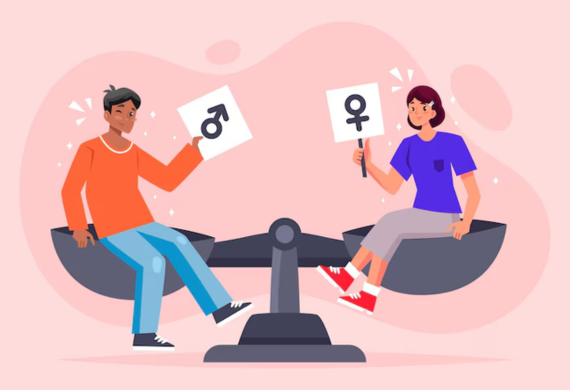
India Slips Further in Global Gender Gap Index for Second Consecutive Year
By: WE Staff | Monday, 23 June 2025
- According to the World Economic Forum's Global Gender Gap Index, which was published last week, India has fallen two spots
- India's ranking has dropped for the second year in a row
- India is currently ranked 131st out of 148 nations
India has continued its downward trend from the previous year, dropping two spots in the World Economic Forum's Global Gender Gap Index. With a gender parity score of only 64.1percent, India is currently ranked 131st out of 148 countries.
After Bangladesh (24th), Nepal, Bhutan, and Sri Lanka, India is among the lowest-ranked countries in South Asia. Given the improved outlook for global gender parity, the decline is particularly significant. In contrast to last year's estimate of 143 years, this year's report projects that it will take 123 years to attain full gender equality worldwide. It's interesting to note that a number of lower-income countries have done better than wealthier ones at closing the gender gap, supporting the notion that economic advancement depends on gender parity.
The index evaluates gender equality in four areas: political empowerment, health and survival, educational attainment, and economic participation and opportunity. In three of these categories, India's performance either stayed the same or slightly improved. However, its overall lower score was a result of a notable decline in political empowerment. Positively, there was a 0.9 percentage point increase in economic participation.
However, at 45.9percent, labor force participation stayed unchanged. Women are disproportionately employed in lower-paying fields like healthcare and education, demonstrating the persistence of gender-based occupational segregation. Women's economic advancement is further restricted by a persistent wage gap and widespread unpaid labor. Even though there has been improvement in health and education metrics, the rate is still slow.
Political empowerment saw the biggest drop. For the second consecutive year, the percentage of women in ministerial positions dropped from 6.5percent to 5.6percent, and the percentage of women in parliament fell from 14.7percent to 13.8percent. India's overall ranking has suffered as a result of these factors. Although the 2023 Women's Reservation Bill has the potential to increase representation, the impending national census may cause its implementation to be postponed until after the 2029 election.
India must increase women's participation in all areas of life, especially the economy, if it hopes to make significant progress. The social and economic impact of even minor advancements can be significant. India will never be able to fulfill its ambition of becoming a developed country until these gender disparities are closed.
Most Viewed
- 1 Women's Health Startup HerMD Closing Doors Amid Industry Challenges
- 2 5 Famous Women in Indian Armed Forces
- 3 Saudi Women No longer Require Male Permission for Clothing Choices, says Prince MbS
- 4 Kolkata Medtech Startup Innovodigm Raises Rs 5.5 Crore Seed Funding Led by IAN Group
- 5 Yamunanagar's Kashish Kalra Honoured after Securing 111th Rank in UPSC Civil Services Exam
- 6 Madurai Appoints Its First Woman Corporation Head
- 7 IAS Vijayalakshmi Bidari Appointed as the new Nagpur Divisional Commissioner
- 8 American Entrepreneur Lucy Guo Overtakes T Swift to become Youngest Female Billionaire
- 9 ICC Women's World Cup 2025 Trophy Showcased at Indore's Holkar Stadium
- 10 Aparna Saxena's Beauty Venture AntiNorm Launches in India
- 11 Vidya Nataraj Co-Founded BlueStone Jewellery & Lifestyle files IPO
- 12 5 Women Freedom Fighters of India
- 13 Dr. G Krishnapriya appointed as CEO for Trichy
- 14 M3M & Sirona Partner to Introduce Menstrual Hygiene Vending Machines in 15 Locations
- 15 Punjab Govt launches SHE Cohort 3.0 Supporting Tech-led Women Startups
- 16 Indian origin Lawyer, Sweena Pannu appointed as the US New Superior Court Judge
- 17 The Aurora Tech Award recognizes 4 Indian Women-led Startups
- 18 Kerala's Republic Day parade featured an all-female tableau
- 19 Manisha Kabbur Becomes Karnataka's First Woman International Karate Coach
- 20 Director K. S. Ravikumar's Daughter Maalica Ravikumar Launches Life Coaching Company 'Evergrowth Academy' for Women
- 21 Leezu's Raises Pre-Seed Funding to Accelerate Growth in Sexual Wellness Industry
- 22 Sattu: Super-easy summer drink for PCOS gut healing
- 23 Swathi Nelabhatla creates Sitha App, India's First Women-Exclusive Gig Platform
- 24 7 Timeless Female Kathak Dancers & their Iconic Legacies
- 25 Meet 7 Iconic Women Architects of Modern India & their Most Impactful Work
- 26 This Woman-led Insuretech Startup is Helping Bridge the Education Financing Gap in India
- 27 Women Leaders Share Lessons Learnt from India Women's WC Win
- 28 5 Enterprising Women Founders Powering Singapore's Tech & Innovation Landscape
- 29 4 Women. 4 Stories. One Vision for Smarter, Stronger Healthcare
- 30 Global Gender Gap Narrows to 68.8%, But Full Equality 123 Years Away: WEF Report 2025
- 31 Changemakers: 7 Women Entrepreneurs Taking the Make in India Movement Forward
- 32 Meet Lucy Guo, The Youngest Self-Made Female Billionaire Disrupting Tech
- 33 How Women are Driving India's Festive Online Shopping Surge






